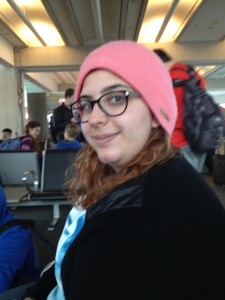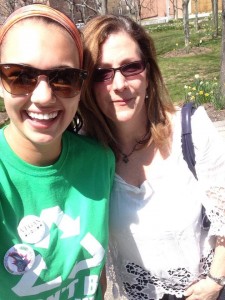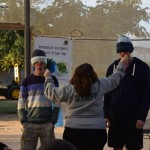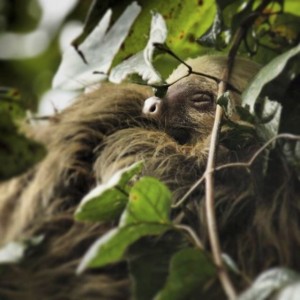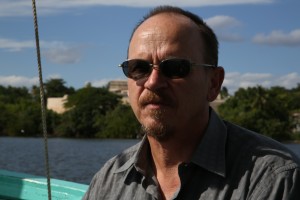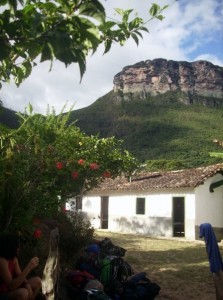“For me, being accepted is another way to meet environmentalists from around the country. I can see what inspires them, and that in turn may inspire me. I am also excited to attend the different workshops, ranging from all about grant-writing to public-speaking.”
Category Archives: Uncategorized
My experience in Kenya
I’ve only been in Nairobi since January 6 of this year, but already the place has made what can only be classified as an indelible impression on me. The vastly different culture, people, and environment found here have all contributed to this feeling. Kenya is a very diverse country and the contrast between the countryside and the city of Nairobi is stark: while rural Kenya offers beautiful nature, and charming small villages, Nairobi is a vibrant third-world metropolis filled with people and traffic.
There are two aspects of my life in Nairobi, the everyday student life, and the more adventurous weekend life where I often travel outside the city. The classes here are a bit different than in the U.S. They are often smaller, and they provide a more Afro-centric view on different academic subjects.
It is fascinating to see how their views differ on the subjects I’ve already learned at Stony Brook University. There are people from all over the continent of Africa at my school, and it is interesting to connect with these people and learn how diverse the continent really is.
On the weekends I travel around in Kenya. I camp in the wild, go on safaris, hike mountains, and visit different parts of the countryside. As a Sustainability Studies major at Stony Brook, it is extremely motivating seeing the beautiful nature and wildlife in Kenya, as it further inspires me to help protect the environment. Seeing animals such as lions and rhinos has truly been an amazing experience.
Besides seeing a lot of nature, I have also joined the climate change branch of an organization called “happy 4 life,” which seeks out sustainable solutions to Kenya’s environmental problems. Interacting with engaged people wanting to make a difference, and fully experiencing Kenya has already taught me a lot, and I am excited to see what is in store for me during the rest of my stay here!

By Sverre Ofstad
Sustainability Studies Program ’15
Sustainability Studies Major
My college experience: finding inspiration and purpose

Andi (fourth from left) with her Sustainability Studies Program classmates and professor, Dr. Jessica Curran (far right) during the 2014 Earthstock festival at Stony Brook University.
After graduating in May 2014 with my BA in Environmental Humanities, I knew it was time to move my career in sustainability forward. So I applied for an internship through the Student Conservation Association (SCA) for a position at a National Park in Vermont. During my phone interview, an SCA recruitment officer asked me: “Why do you want to connect people with nature?”
The perfect question. My response was: “I love nature, I love everything about it and I so desperately want to save it from a human-created demise. That being said, I don’t believe the world will try hard enough to save it unless it sees the environment as I do, as a nurturer. I want to dedicate my life to showing people to love our environment, so they will try as hard as I do to save it.” Or something along those lines. (It was probably crunchier; I was having a moment.)
In my response, I went so far as to quote Earth In Mind, a book by eco-critical author David Orr, which was included in the Sustainability Studies Program curriculum I followed at Stony Brook University. I find Orr’s work not only completely eye-opening, but absolutely inspiring. I find peace with his words and consolidation in his thoughts. Yet it’s incredible to think that I probably would have never read his work if I had not been exposed to it in my studies at Stony Brook.
My answer to the SCA recruitment officer’s question was very much inspired by David Orr, but also by my Sustainability Studies Program professors. Not only did they give me direct inspiration with reading lists, but they served as the actual muses themselves. Dr. Jessica Curran is the reason I still keep a journal, have a blog and write haikus for fun. Dr. Heidi Hutner is the reason I got into activism. She taught me a new kind of passion, a protective and honest passion.
What’s funny is that before I was asked that question during the interview I would not have been able to tell anyone what I specifically wanted to do with my life. But that question was all I needed to realize that I wanted to go into environmental education. Now I am an interning as an environmental educator for N.Y. State Parks, providing experiences for people to have with nature, hoping that these experiences will lead them to love the environment as much as I do.
When people ask me about my experience at Stony Brook University I am not one of those people who complain about classes being too big or professors not knowing my name. That was not my experience. When I talk about Stony Brook I speak of how tight-knit my program was, how my professors not only knew my name but knew my dog and had my phone number. I talk about how I would get a text about a county legislature hearing happening the next day, and my professors would tell me to go, speak up: you must go out and make your voice heard if you’re going to change the world.
By Andi Burrows
Sustainability Studies Program ’14
Environmental Humanities Major
Today Andi is interning as an environmental educator with N.Y. State Parks.
Program alumna works to bring about positive social and environmental change
The Stony Brook University Sustainability Studies Program prides itself in not only what its students do inside the classroom. We’re also highly-focused on helping our students and alumni land meaningful employment in the sustainability sector. We’re especially proud of Shameika Hanson, a program alumna who graduated with her B.A. in Environmental Humanities in May 2014.
Shortly after graduating, Shameika was hired by Beacon, N.Y.-based environmental and social advocacy group Hudson River Sloop Clearwater, Inc. Working as Volunteer Coordinator and Events Supporter, Shameika helps unite people, specifically through music and education, so that they can work together toward positive environmental and social change. Music and education are the two key strategies used by Clearwater, which was founded in the late 1960s by musician and activist Pete Seeger, to bring about such changes.

Shameika Hanson (left) with Clearwater co-worker Linda Richards at the Martin Luther King, Jr. Day celebration in Beacon, N.Y.
On January 20, Shameika attended a Martin Luther King, Jr. Day celebration in Beacon with Clearwater co-worker Linda Richards, director of music and events. Together the pair marched and sang, praising Dr. King for his achievements in civil rights. Shameika described King as “a great person who had great people behind him.” She added, “There’s still work do. We should all be Dr. Kings.”
In her new position at Clearwater, Shameika embraces the spirit of King and other great activists. Through music and education, she encourages Clearwater volunteers and the public to get involved in their communities to help other people and the environment.
The full story on Clearwater’s involvement in the Martin Luther King, Jr. Day celebration in Beacon can be found here.
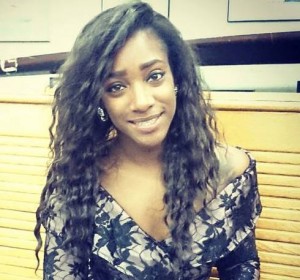 Shameika Hanson
Shameika Hanson
Sustainability Studies Program ’14
Environmental Humanities Major
Sustainability Studies Program earthworm research recap, 2014 edition!
During my first semester with the Sustainability Studies Earthworm Ecotoxicology lab, back in January 2012, I had seven brave students working with me. We wanted to examine the effect of acid rain on earthworm health, so we designed and ran the research—and made a lot of mistakes. Some of them were pretty funny. As a primate behavioral ecologist, I didn’t know a lot about earthworms. Who knew that earthworms wouldn’t stay in the containers you put them in? Who knew that fungus gnats from earthworm soils could take over a greenhouse? Well, we know those things now!
With more than thirty students working in the lab each semester, we’ve conducted handfuls of important research. We’ve looked at the effects of substances like fertilizer, Ortho Weed B Gon and Roundup on earthworm health. We’ve submitted a total of six posters to URECA. We’ve helped one student conduct her research for the Honors College, and we’ve participated in the Earthstock Keynote address.
The earthworm students work in groups, run by team leaders. They come to me with ideas, we work though the logistics and hone their hypotheses, and then those students organize the manual labor, data collection and write up. In keeping with that spirit, my current group of students, who are divided into two smaller sub-groups, describe their current research below:
The Cadmium Project
The goal of our experiment is to determine how long it will take to breed cadmium-resistant earthworms. We predict that it will take more than 4 months for the cadmium resistant earthworm to sustain a fertility rate that is comparable to those of normal earthworms. Cadmium is a known pollutant that has negative effects on the fertility of earthworms. This substance enters the environment through sewage waste, as well as its use in manures and pesticides. This chemical is known to affect the earthworms by markedly decreasing the amount of cocoons that can be produced by earthworms per reproductive cycle. To test our hypothesis, we are placing earthworms in soil that has had a cadmium solution applied to it in varying amounts. The soil will be tested over a period of 6 months for microbe respiration. Additionally, we will be determining the resulting earthworm mortality and biomass. This experiment has given us the opportunity to raise awareness to others about the potential dangers of using these particular chemicals.
The Roundup Project
At the Life Sciences Greenhouse, we’re testing the effect of Roundup on soil microbial respiration and earthworm mortality, the supervision of Dr. Pochron and with the assistance of Michael Axelrod and John Klumpp. This project is an interdepartmental collaboration between Sustainability, Biology and Chemistry. We want to see if Roundup, a popular household herbicide, affects soil microbial consortium and worm mortality. Since earthworm presence indicates healthy soil activity, we predict Roundup will negatively affect soil microbial respiration and increase worm mortality. Results from this study will help elucidate the effects of anthropogenic herbicide use on soil ecosystems. Working in the lab, we learn to independently conduct experiments through hands-on experience.
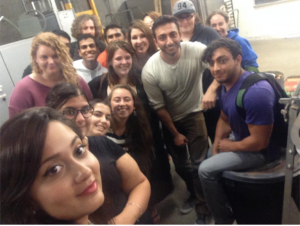
Many of the Fall 2014 worm lab students gathered in Stony Brook University’s Life Science Greenhouse.
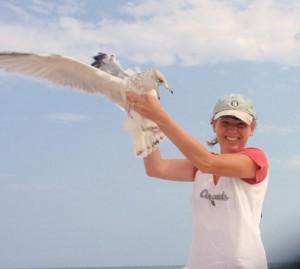 By Sharon Pochron, Ph.D.
By Sharon Pochron, Ph.D.
Professor and Earthworm Ecotoxicology Researcher
Sustainability Studies Program
The Salad Trail: An organic oasis in the middle of a desert
Stony Brook University Sustainability Studies Program student Emily Nocito found that the Salad Trail in Israel’s Negev Desert is a most unexpected organic oasis.
The Negev Desert of Israel: not the place one would think about when it comes to agriculture, especially taking into account the varying temperatures. In the summer, temperatures can be as hot as 100°F, while at night can drop to nearly 30°F. However, one place, The Salad Trail, is defying all odds by creating a sustainable farm in the middle of this barren land.
How do I know this? I had the pleasure of visiting the farm, along with 39 other students, 7 Israel Defense Force soldiers, and four staff members during this winter’s Taglit program. In the middle of January, in this huge desert, I was picking kumquats straight off the tree. I ate many different types of tomatoes, all grown in a greenhouse. I witnessed some of my friends try a habanero pepper fresh from the vine (no way I was going to eat that!). The Salad Trail, thought up and owned by a lovely agronomist named Uri Alon, seeks to educate a wide range of ages through a commonality we all love- eating.
Along with learning about how they operate their farm- like all the water used is recycled wastewater from Tel Aviv, and the temperatures are controlled using energy from their solar panels, we learned about the struggles of sustainable growing in such harsh conditions while eating our way through the various greenhouses. In the strawberry room, we learned that the strawberries were grown in turf made from coconut shells rather than soil. When asked how they dealt with pests, our lovely tour guide surprised me with her response: Rather than using pesticides, they call up a kibbutz that breeds bugs. They tell the workers there what type of pest they have, and the members of the kibbutz send them a natural predator to the pest. Thinking ahead, they only send males, preventing their reproduction.
Never in my wildest dreams did I think I would find an organic oasis in the middle of the Negev.
By Emily Nocito
Sustainability Studies Program ’16
Coastal Environmental Studies Major
Ecosystems and Human Impact Minor
Reflections of a senior EDP major
The Stony Brook University Sustainability Studies Program offers students an intimate learning experience and a number of great academic and career-development opportunities thanks to the program’s enthusiastic faculty and staff.
As a senior Environmental Design, Policy and Planning major, I can speak from my own experience about how dedicated the professors are, and how many excellent opportunities they offer students not only on campus, but outside of the classroom as well.
In the two-and-a-half years I have been part of the program, I have been given the opportunity to attend exciting events such as the third-annual Global District Energy Climate Awards in New York City and Vision Long Island’s 13th-annual Smart Growth Summit. Events like these have given me first hand experience of a number of different “planning” fields, and I feel that these experiences are very helpful in guiding students toward their future career path.
The Sustainability Studies Program has also offered me the opportunity to study overseas, where I gained valuable and marketable international skills in sustainability. Last winter, I traveled to Costa Rica, an international leader in renewable energy. There, my classmates and I developed and proposed ideas aimed at further improving the country’s sustainability, while also bolstering its economy. It was an invaluable experience to receive feedback about these proposed ideas from my peers, professors and Costa Rican citizens themselves.

Our SBU Sustainability Studies Program Costa Rica Winter 2014 study abroad group at AeroEnergia, a wind-based Costa Rican energy company.
Opportunities like these give students experience outside of the classroom that can give them an edge when beginning their careers or gaining admission into sustainability-related graduate degree programs. Overall, Stony Brook University’s Sustainability Studies Program offers an enriching academic experience and prepares students well for life after graduation.
 By Michael Loper
By Michael Loper
Sustainability Studies Program ’15
Environmental Design, Policy and Planning Major
Documenting Cuba’s cultural mission to help protect the environment
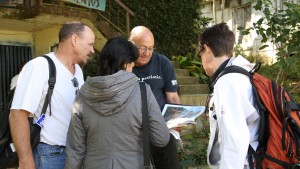
José Oriol Gonzáles, the director of Teatro de los Elementos, speaking with Karina Pino of Artes Escencias, Melinda and me.
From October 29 to November 5, 2014, my colleagues Professor Melinda Levin (University of North Texas) and Filip Celdander (University of Texas, Dallas), and I traveled to Cuba under a cultural visa given to us by the Cuban Ministry of Culture to collaborate with Artes Escenicas, Cuba’s leading performing arts organization, to film performing arts groups in Cuba doing environmental outreach.
Over the week, we filmed Teatro Cabotin in Sancti Spiritus, Teatro de los Elementos in Cumanayagua, La Fortaleza in Juragua, and Teatro de Colaboracion con el Medio Ambiente in Romerillo-Havana. The goal of this collaboration was to explore the use of performing arts as a form of outreach and education. We stayed in small Cuban communities, living with the locals. One community, Teatro de los Elemntos, has an organic farm and the locals there live sustainably. There and elsewhere, we noted the specific community issues locals are addressing and in our filmmaking emphasized their creative responses to problems/challenges with the environment.
Our documentary work is meant to help us better understand the creative process, the daily lives of the artists and community members, and the connection between art, community and positive social change. My colleagues and I gathered over twenty-five hours of film footage of performances and interviews as well as thousands of photos of locations and performances. The products of our research will include published essays and interviews, short documentary films and eventually a longer work on Cuban arts and the environment.
Artes Escenicas has already invited our group to return and collaborate more extensively in 2015. This year we will work more intensely with Teatro Cabotin and Teatro de los Elementos, and will also travel to Las Tunas to film Teatro Tuyo and its latest theatrical work, Gris. The director of Teatro Tuyo, Ernesto Parra, explains that the purpose of Gris is to raise awareness of the importance of environmental protection.
By David J. Taylor, Ph.D.
Visiting Professor of Sustainability
Sustainability Studies Program
E grant used to boost education, minimize environmental impact
When it comes to being a college student, it’s not always easy to minimize your environmental impact. While use of the Internet and other technologies like e-textbooks has become more common in recent years, most classes still require that you use at least some paper to take exams, complete assignments, write notes and review class readings.
But this past semester, Stony Brook University Sustainability Studies Program professors Dr. Arlene Cassidy and Dr. Anthony Dvarskas created a completely paperless course based on the use of electronics to minimize the class’ environmental impact while maintaining high educational standards and increasing students’ exposure to the use of technology in education.
To eliminate the need for paper printed textbooks, exams, paper presentations, homework, scheduling and other course-related items for their course–SBC 401: Integrated, Collaborative Systems–Cassidy and Dvarskas used an “E grant” (a college grant for the use of technology for educational purposes) to obtain electronic tablets for each student.
The professors also used Blackboard, Stony Brook University’s online course-support platform and email to communicate with students, distributing Internet-based reading material, projects, tests and announcements. Besides communicating with their professors, students collaborated with each other online, sharing data and projects, as well as creating group presentations. Additionally, all scheduling and student/course evaluations were completed online.
Want to learn more about SBC 401?
Drs. Cassidy and Dvarskas describe the course below:
“The primary course objectives of SBC 401 are to develop a way of thinking about complex systems in present-day society, and to provide the necessary research, communication, and team-based skills to address the complex problems involved with coastal regions. The course is organized as a seminar/research project course. As part of the course, the instructors provide practical training in the skills needed to work in teams to conduct research and communicate the results. The teams of students develop a project related to coastal restoration, collect the necessary data (either from databases or through limited field work), analyze the data, and synthesize their findings into a presentation at the end of the semester.
This fall, the focus of the course was on an issue very important here on Long Island: coastal restoration. Several people in the Stony Brook University community have been and are involved with coastal restoration projects and were able to share their expertise and research with the students. Students also were able to gain on site experience visting two local beach restoration projects; West Meadow Beach and Sunken Meadow’s beaches.”
 Arlene Cassidy, Ph.D.
Arlene Cassidy, Ph.D.
Environmental Economist, Lecturer and Director
Sustainability Studies
Sustainability Studies Program
Anthony Dvarskas, Ph.D. Environmental Economist, Coastal Environmental Scientist, Lecturer
Environmental Economist, Coastal Environmental Scientist, Lecturer
Sustainability Studies Program
Taking the long road
In 2008, I was hopeless. College? How was I supposed to know what to study? My nature-photographer father ‘s voice rung in the background, telling me to follow my passion.
The thing is, art was my passion. Art schools were out of my family’s budget, and coming from a family where both of my parents were artists, I was able to witness the ups and downs of the art world. I knew committing my college degree to art would not be the wisest choice. My mother urged me to take up writing. In her opinion, I wrote “terrifically,” and I had a “god-given talent,” but, writing was not my passion, and frankly, I never believed her. I loved traveling, learning about new cultures and meeting new people, but I heard that the chance of nabbing a job in the field of anthropology was slim to none.
I didn’t want to spend days in a studio making art or writing, because that would deprive me of nature’s elements. And studying cultures would lead me to a lab or minimum-wage fieldwork. But, I did know that I loved the natural world. From childhood, the outdoors felt more like home than my actual house. My memories are filled of games played in fern-laden oak forests, adventures in reed-walled marshes and fresh water ponds filled with minnows, and crabbing along the dunes of the Atlantic coast. As a child, I established a deep soul-enriching connection and understanding of the natural world.
I didn’t know what to I wanted to study. I wanted to focus on an area that would teach me how to improve the existing world, but no major seemed to fit me. I didn’t know what I was looking for, and I couldn’t find anything that sparked my interest. So, in the fall of 2008, I ignored my inability to muster more than a B- in science or math, and took up an Environmental Studies major at Stony Brook University Southampton.
Well, by the spring of 2009, I knew I was not ready to embark on an environmental major. Not only was I barely passing my classes that were mainly science- and math- based, but most of the information I was learning was disheartening. I saw no light at the end of the tunnel. I could not overcome the anxiety I experienced when I learned about the statistics of our future planet. It all sounded so bad. I left Stony Brook University Southampton and went to Suffolk County Community College where I began my Liberal Arts degree.
Let me take a step back to the time before I attempted an Environmental Studies major. My first experience of understanding the spiritual and philosophical aspect of the natural world dawned on me when I was sixteen. My high school gave students an opportunity to travel to India for ten days. This trip shocked my understanding of life.
Before this trip, I was like most other teenaged girls. I read fashion magazines, wore horrific make-up, bought cheap clothes and jewelry in order to fit into the newest trends. I was falling into the superficiality that American consumerism offers. I became interested in India after a class on world religions I had taken that year, and Hinduism captured my interest the most.
In Hinduism, there is a great respect for other living things. Cows are worshiped, and there are an infinite amount of gods, goddesses and deities who represent all parts of the physical and spiritual world. Well, India woke me up from my superficial stupor. My first encounter with India was the smell of cremating bodies that filled the vents of the landing jet. I cried when we finally got on our tour bus. Naked, malnutrition-bellied children pounded on the side of our bus with their handicapped mothers, signaling for food with their empty palms and stick-like fingers. They ran along the bus, through the heavy crowds, as we drove away.
But, among the dirt, there was beauty and hope in the people. Women adorned themselves in vibrant colored saris and jewel encrusted gold chains and nose-rings. The culture was so strong here. Yet, I was enraged by the injustice. Half of my clothes were made in this country. My garbage was taken here, left to be searched through by those pot-bellied children. But, why were they succumbed to this life of starvation and sickness when there were fields of potatoes, okra, peas, curry, and sunflowers not far from the city? Mainly, for money. This trip was a turning point. I witnessed the ugly reality consumerism and globalization has created for other people in this world, and they do not deserve it.
During the three years after this trip, I continued to travel. I came across once-in-a-lifetime opportunities to travel to some of the most amazing places on Earth. I found myself swimming with seals in the Galapagos, starring at ancient glaciers in Patagonia, Argentina, and even nearly encountering a jaguar in the Amazon Forest in Brazil. My highest point of awe was in Brazil. I was one of eleven students from around the world who were accepted into a backpacking/study abroad program there. We traveled through multiple provinces in the Northern area of the country to study the ecology, geography, culture, and forms of sustainability present there.
Mid-way through our 45-day trek, we arrived to Chapada Diamantina National Park. The park is located in the Chapada dos Veadeiros, an ancient plateau with an estimated age of 1.8 billions years, and is the highest plain in Central Brazil. We hiked through rain and mist for three days. On the fourth, the skies cleared and we came to one of the highest plains in the park. Below, we saw a beautiful valley that looked like it never ended. The valley’s rock walls were lined with gushing waterfalls, casting rainbows in their mist. It was like being at the top of the world. The air was so clean. The sight around me was breathtaking. I remember thinking, This is how the world should be.
Now back to my college story: With my time at Suffolk County Community College drawing to a close, I knew I wanted to find a way to objectify and communicate how beautiful the world is, and what it has to offer us outside of food, water, and gas. I graduated from Suffolk County Community College with an Associates in Arts degree in 2010. Back to the drawing board it was.
I decided to look back at Stony Brook University. After a short phone call, I discovered that I was still a Stony Brook student. My mind was somewhat set at ease. I immediately began searching through the majors. Anthropology: no. Art: no. Coastal Environmental Studies: I wish. English: no.
Then, I found a major I had never heard of before: Environmental Humanities. The major consisted of writing, literature, philosophy, social science and environmental art & aesthetics. Everything I loved was encompassed in this major, and all of it was centered around the environment. I felt like this major was made for me. To this day, I do not regret taking the long road to discovering my passion. Now, almost seven years after I began my endeavor into getting a higher education, I am studying how to communicate environmental issues through design and art. I couldn’t have imagined a better way for me to invest my years of education.
By Isabella Bartoloni
Sustainability Studies Program ’15
Environmental Humanities Major



